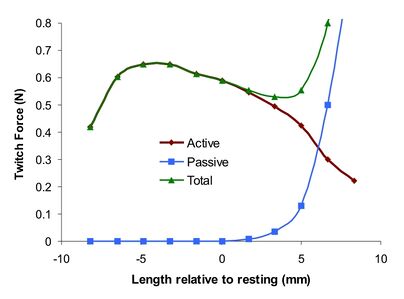Action of Which Two Muscles Allows the Patient to Continue Flexion
Introduction [edit | edit source]

The terms active and passive insufficiency are important concepts in exercise programs: understanding the implications will help you design exercises that are more efficient and less injurious. Both active and passive insufficiency are functional states that occur in multi-joint muscles only.
- Active insufficiency occurs when a multi-joint muscle shortens over BOTH joints simultaneously, and hence, creates so much slack, that muscle tension is almost completely lost.
- Passive insufficiency occurs when the multi-joint muscle is lengthened to its fullest extent at both joints, but also preventing the full ROM of each joint it crosses.[1]
Image: Length Tension Curve of muscle - The key feature of the length-tension relationship is the extra force that can be exerted during muscular contractions when the passive elements are able to contribute, which occurs when the muscle is elongated to long lengths during normal strength training, and also during eccentric training.[2]
Active Insufficiency [edit | edit source]

The active insufficiency of a muscle that crosses two or more joints occurs when the muscle produces simultaneous movement at all the joints it crosses and reaches such a shortened position that it no longer has the ability to develop effective tension[3]. When a prime mover (agonist) becomes shortened to the point that it cannot generate or maintain active tension, active insufficiency is reached.
Image 2: Biceps at active insufficiency
- The shortening of the Rectus femoris limits full hip flexion when the knee is fully extended.
- Maximal shoulder flexion cannot be achieved simultaneously with maximal elbow flexion due to the shortening of the Biceps Brachii.
- Maximal knee flexion and maximal plantar flexion are limited due to the shortening of the gastrocnemius.
- Full knee flexion and full hip extension cannot be achieved simultaneously due to the shortening of the hamstrings. [4]
Passive Insufficiency [edit | edit source]

When the opposing muscle (antagonist) is stretched to a point where it can no longer lengthen and allow further movement, passive insufficiency is reached. This limitation is a normal property of multijoint muscles and helps optimize the relation between muscle length and tension.[5] Passive insufficiency occurs when a multi-joint muscle is lengthened to its fullest extent at both joints, but also preventing the full range of motion of each joint it crosses.[6]
Image: Quadriceps passive insufficiency - Most of use would have reached our quadriceps length of passive insufficiency by now.
- Full finger flexion cannot be achieved if wrist flexion occurs simultaneously.
- Maximal hip flexion and maximal knee extension are limited by the lengthening of the Hamstrings.
- Full knee flexion is limited by the stretching of the Rectus femoris if the hip is fully extended.
[7]
Clinical Relevance [edit | edit source]
During rehabilitation, each joint should be moved individually through its available range of motion in order to optimally improve or maintain the amount of range of motion at that joint.
- Try to Avoid Active Insufficiency in Exercise: Compound exercises by their nature will recruit muscles in a more natural and efficient manner.
- Isolation exercises, while holding importance for goals like bodybuilding and targeting weakened muscles, may not always be a great choice for a strength, general fitness, or weight-loss clients[1].
- Resting length produces optimal force in muscles.
- When considering sports activities like sprinting or kicking a ball, passive insufficiency of the hamstring complex can cause injury.
- If a client seems to consistently struggle with particular movements you can determine if active or passive insufficiency is playing a role and adjust accordingly.[1]
References [edit | edit source]
- ↑ 1.0 1.1 1.2 NFPT Understanding Active and Passive Insufficiency Available from:https://www.nfpt.com/blog/understanding-active-and-passive-insufficiency (accessed 6.5.2021)
- ↑ Askinglot Length tension curve Available from: https://askinglot.com/what-is-the-length-tension-curve (accessed 6.5.2021)
- ↑ Clarkson HM. Musculoskeletal assessment: joint range of motion and manual muscle strength. Lippincott Williams & Wilkins; 2000.
- ↑ GUStrenght. What is Active Insufficiency of Muscle. Available from: https://youtu.be/FT7OABz8I5k
- ↑ med dictionary Available from:https://medical-dictionary.thefreedictionary.com/passive+insufficiency (accessed 6.5.2021)
- ↑ 1. Rogers M, Rogers M. Understanding Active and Passive Insufficiency [Internet]. National Federation of Professional Trainers. 2020 [cited 17 September 2020]. Available from: https://www.nfpt.com/blog/understanding-active-and-passive-insufficiency
- ↑ Dr. Veronica Foster. Biomechanics Lecture 19 - Active and Passive Insufficiency. Available from:https://youtu.be/vCEYDZvox2s
Source: https://www.physio-pedia.com/Active_and_Passive_Insufficiency
0 Response to "Action of Which Two Muscles Allows the Patient to Continue Flexion"
Post a Comment